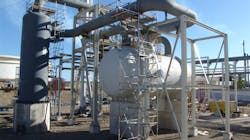New England Clean Hydrogen Hub Grows to 7 States
Vermont has signed on to a multi-state agreement, joining with New York, Connecticut, Maine, Massachusetts, New Jersey and Rhode Island, to develop a proposal to become one of up to 10 regional clean hydrogen hubs designated through the federal Regional Clean Hydrogen Hubs program included in the bipartisan Infrastructure Investment and Jobs Act.
The Northeast Clean Hydrogen Hub of seven states and more than 100 clean hydrogen ecosystem partners is moving forward to develop and submit a full proposal to the Department of Energy to compete for funding through the $8 billion program, according to a release by the New York State Energy Research and Development Authority.
Since the initial announcement in March 2022, the Northeast Clean Hydrogen Hub has added partners from all parts of the clean hydrogen ecosystem, including private sector industry leaders, infrastructure and logistics experts, non-profits, technology and equipment manufacturers, hydrogen project developers, transportation leaders, utilities and state agencies.
"To tackle climate change, we'll need a multi-pronged approach that relies on innovation and cooperation. In Vermont, we're working to do our part and ready to collaborate with the other states across our region in exploring ways to promote a clean energy future,” Vermont Department of Public Service Commissioner June E. Tierney said.
The Regional Clean Hydrogen Hubs program – or H2Hubs – includes up to $7 billion to establish six to 10 regional clean hydrogen hubs across America. As part of a larger $8 billion hydrogen hub program funded through the Bipartisan Infrastructure Law, the H2Hubs will create networks of hydrogen producers, consumers and local connective infrastructure to accelerate the use of hydrogen as a clean energy carrier that can deliver or store energy.
Newly added partners to the Northeast hub include Mitsubishi Power Americas, Alstom, Enbridge, Mainspring Energy, Universal Hydrogen Co., Spotimyze Energy, Corning, AES and others.
Utilities that have joined include Public Service Enterprise Group, NextEra Energy Resources, Dominion Energy and others.
Institutional partners for the effort include the Electric Power Research Institute, Brown University, Rutgers University, Massachusetts Institute of Technology, Princeton University and others.
Previously announced partners included Consolidated Edison Co., Bloom Energy, National Grid, Standard Hydrogen Corp., Plug Power, Orange and Rockland Utilities, and the New York Power Authority.
Northeast Clean Hydrogen Hub partners have committed to collaborate with state governments on proposal development to advance clean hydrogen projects.
Partnering states will also coordinate with their respective state entities to help align the collaborative's efforts with each state's climate and clean energy goals.
The group will continue to focus on the integration of renewables - such as onshore and offshore wind, hydropower, and solar PV - and nuclear power into clean hydrogen production, and the evaluation of clean hydrogen for use in transportation, including for medium and heavy- duty vehicles, heavy industry, and power generation applications or other appropriate uses consistent with decarbonization efforts.
About the Author
Jeff Postelwait
Managing Editor
Jeff Postelwait is a writer and editor with a background in newspapers and online editing who has been writing about the electric utility industry since 2008. Jeff is senior editor for T&D World magazine and sits on the advisory board of the T&D World Conference and Exhibition. Utility Products, Power Engineering, Powergrid International and Electric Light & Power are some of the other publications in which Jeff's work has been featured. Jeff received his degree in journalism news editing from Oklahoma State University and currently operates out of Oregon.
